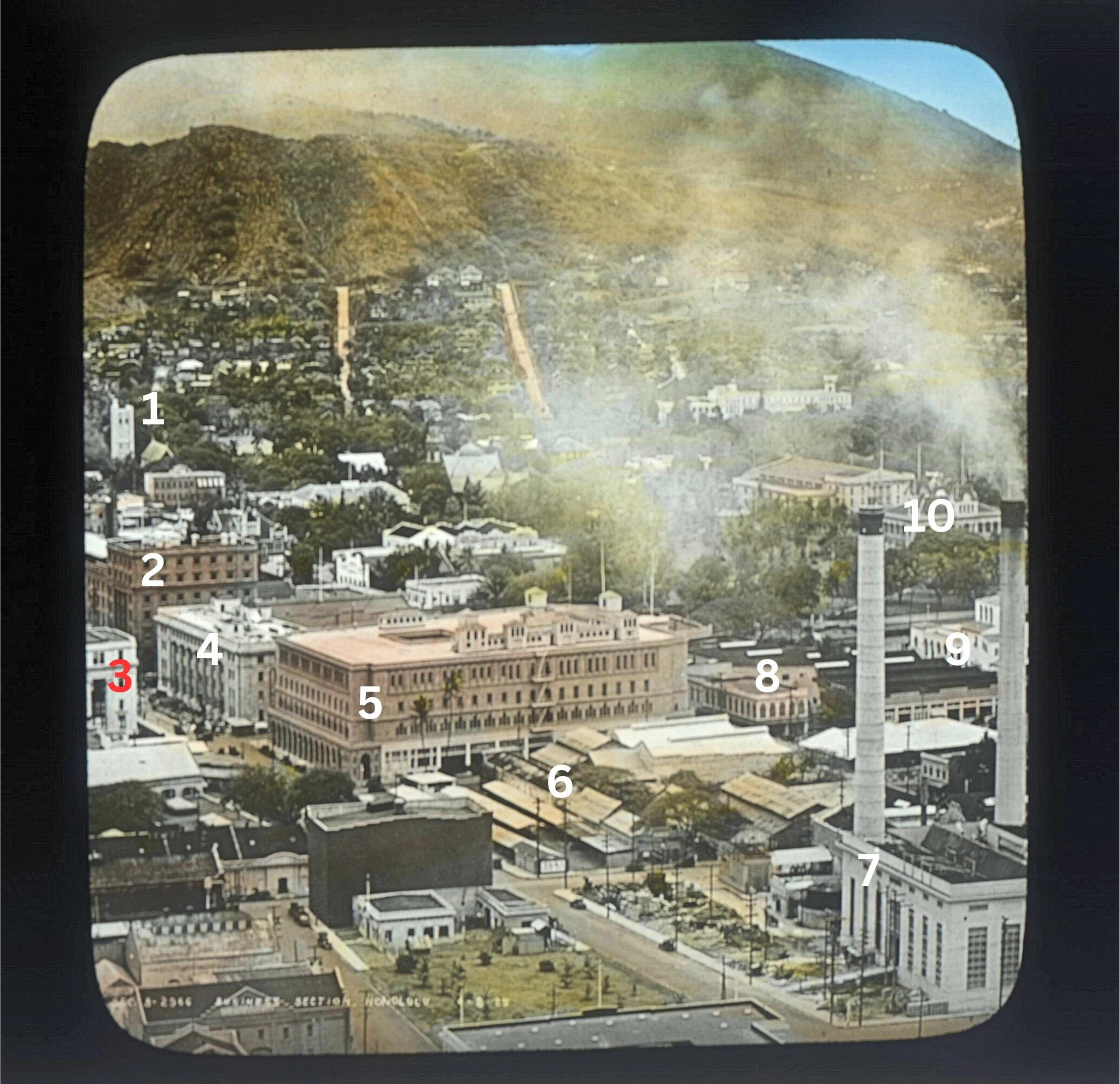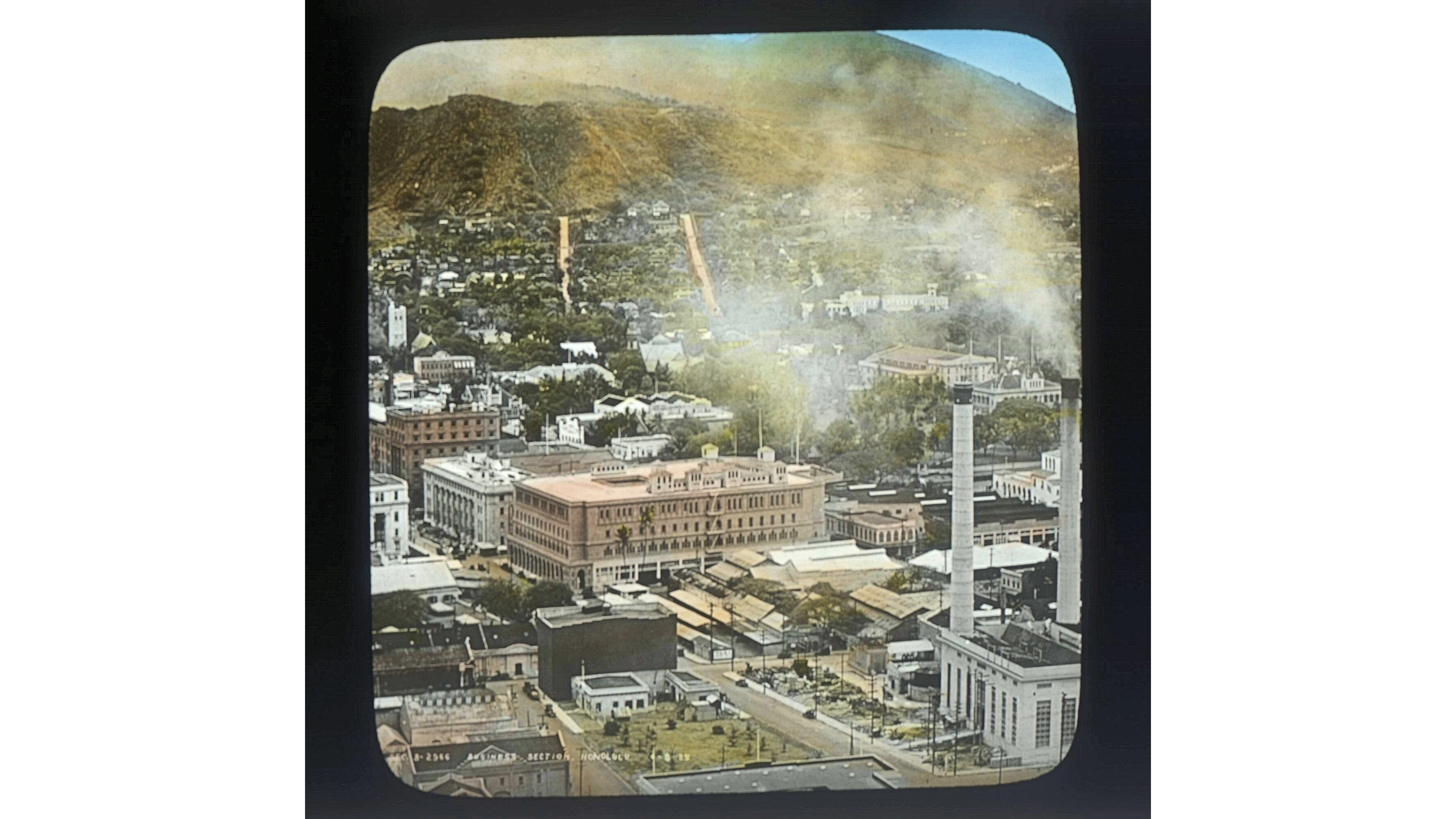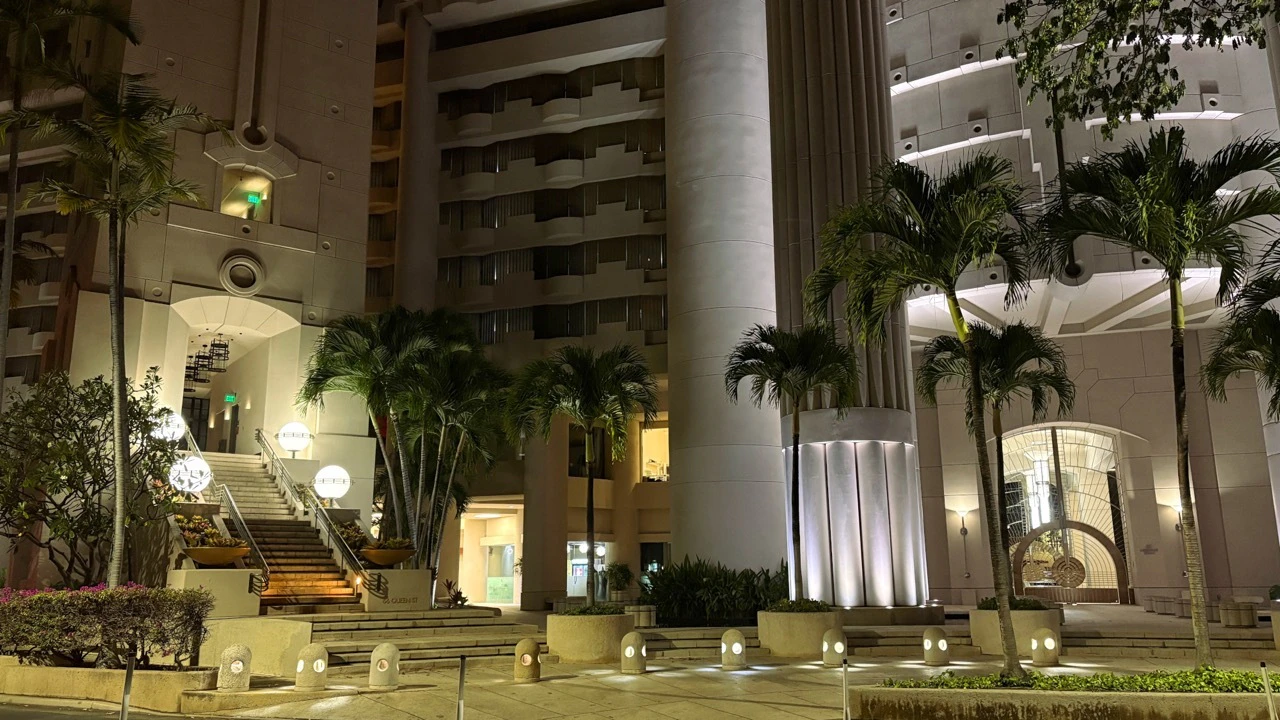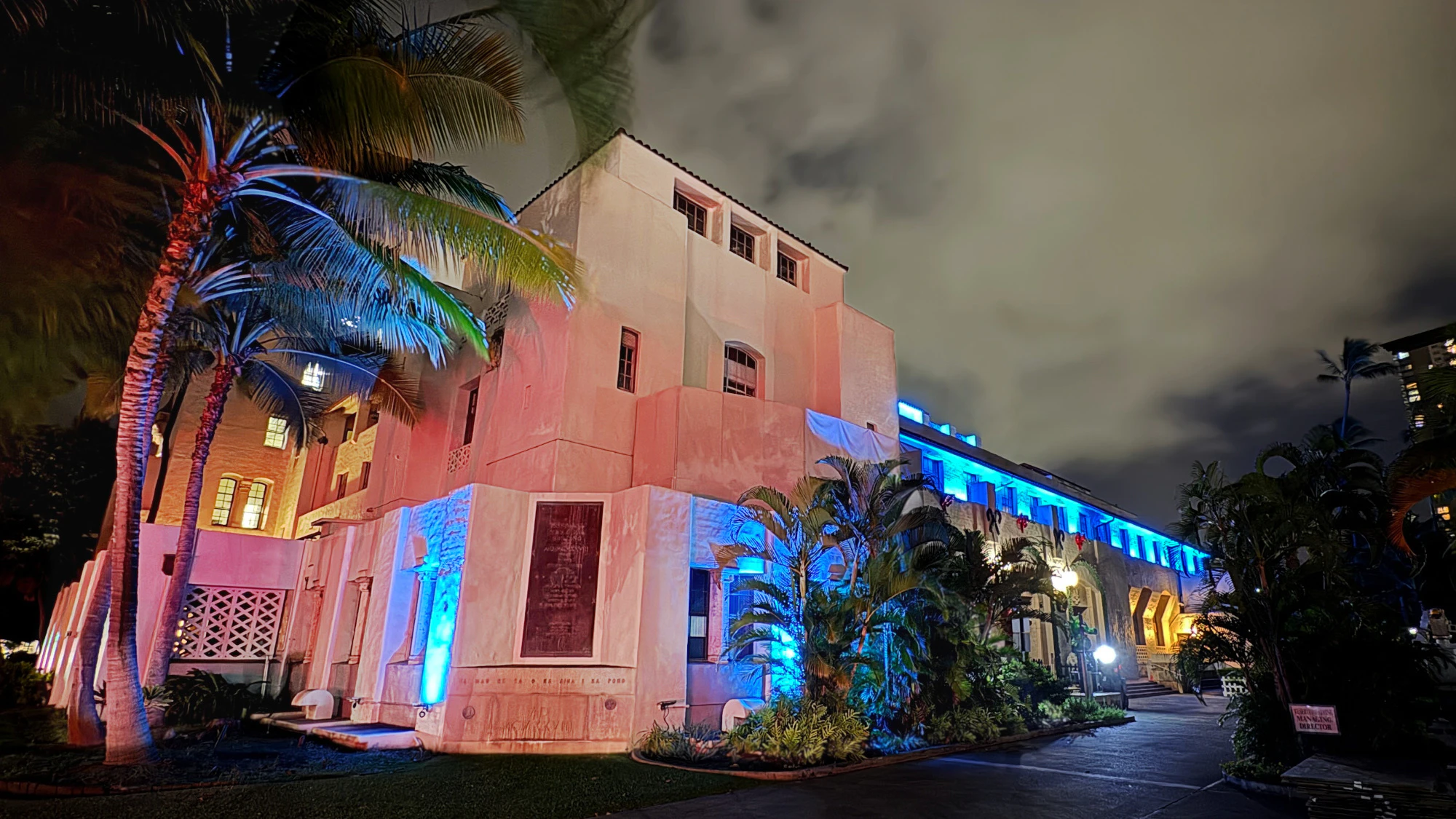I ran across this image while checking out the online offerings of historic Hawai‘i photos at the University of Hawai‘i at Mānoa Library Digital Image Collections. The date jumped out at me — April 1925, a hundred years ago, to the month.
The image is described as "Business section of Honolulu," dated April 8, 1925, donated by the Seiju and Ayako Ifuku family. Itʻs called a "lantern slide," a forerunner to technology like the Kodak 35mm film slide, meaning the image was used to throw a projection onto a screen.
Does anything here look familiar to you?
Letʻs toss some numbers into this for a quick tour of the city as it was:

1 — One of the few survivors to the present day is The Cathedral of St. Andrew. This would've been a familiar old landmark even in 1925. "The design of the magnificent structure was inspired by the Gothic Cathedrals in Europe visited by Queen Emma during a trip in 1865," writes the cathedral. The cornerstone was laid in 1867. For a deeper dive into the cathedral's history, visit here.
2 — Long gone. This is the Alexander Young Hotel, which opened in 1903, served as a hotel until a conversion to offices in 1964 and was torn down in 1981 to make way for what you see now on the corner of King and Bishop streets, Bishop Square.
Not without controversy at the time. Hawai‘i News Now has a collection of KGMB news stories about efforts to save the hotel archived on YouTube, here. Check that out for plenty of live action shots of the hotel as it was, for interior shots of the hotel as its parts were sold, and clips of protests in the streets as the wrecking ball swung.
It was a big deal.
You see a man and a woman in the first segment arguing in favor of preserving the hotel who are unnamed in the video. They are the late Michael Leineweber, architect, and the late Spencer Leineweber, architect, preservationist and UH Professor at the School of Architecture. The duo were founding members of the Historic Hawai‘i Foundation in 1974. Learn more about Spencer's preservation work in this biography.
3 — This is not the famous Alexander & Baldwin Building, though it's in the same location. The A&B Building would be built four years later, in 1929.
4 — The Damon Bank Building, of the Honolulu Bank of Bishop & Co., forerunner to First Hawaiian Bank. Torn down in 1993 to make way for the present First Hawaiian Tower. Again, not without controversy. Here's an editorial tribute to the Damon Bank Building by, naturally, Spencer Leineweber, archived on Reddit.
This is one of the few long-lost buildings I actually remember, back when I worked at Mission Houses Museum in 1992 and would walk into downtown for lunch.
5 — The Theo H. Davies Building, designed by Louis Christian Mullgardt and constructed between 1917 and 1921, making it perhaps the youngest building at the time this photo was taken. Follow that link for more details on the unique concrete construction of that building and a close-up photo of it. The block included warehouse space, as Honolulu in 1925 had more of a light industrial nature at the time.
It was replaced in 1972 with the current Davies Pacific Center. No warehouse space in that, but if you walk around the building you'll see cast-in-concrete murals depicting the various industries the Theo H. Davies company had engaged in, including whaling. Developer Christine Camp's Avalon Group acquired the building in 2023 with plans — now on hold due to shifting market conditions — to convert much of the office space into apartments.
6 — Speaking of Honolulu's maritime and light industrial past, here is a collection of sheds and warehouses in what would be their last days. Four years after this photo was taken, the Dillingham Transportation Building would be built on the ‘Ewa side of the block. The Diamond Head side of the block would eventually become the home of Grosvenor Center, with the makai tower completed in 1979, the mauka tower in 1981. That complex is now known as Pacific Guardian Center.
A couple notes on Pacific Guardian Center: It was designed by AHL, then known as Architects Hawai‘i, Ltd., by architect Joe Farrell. In an interview so long ago that I can't find it on the internet, Farrell described to me the pains he took to clad those towers in glass so blue that they would match the sky and essentially disappear. He was also proud of the parking garage, which is completely integrated into the glass towers. AHL is still ensconced in the makai tower.
7 — This obviously industrial building was new at the time, built in 1920 as the Hawaiian Electric Co.'s downtown power plant. Physically, the property is still that, though the plant itself was deactivated in 2014, according the Honolulu Star-Advertiser. "The plant’s history dates back to 1920 when the site at Halekauwila and Alakea Streets was first constructed, the company said," wrote the paper. "Its location was particularly meaningful, as it sits at the harbor where whaling vessels once off-loaded the oil that was used to power the city’s lamps."
8 — At last, a business district survivor! According to city records, this two-story commercial building at Queen and Alakea Street is now owned by The Hawai‘i Buddhist Cultural Society. It is occupied entirely by Fo Guang Shan Hawai‘i, with its Buddhist temple upstairs and its restaurant, Water Drop Vegetarian House, Inc., on the ground floor.
Those records describe a building improvement titled "Queen's Plaza" as built in 1950, with an "effective year built" of 1965, to do offices upstairs and retail downstairs. The exterior is identified as "default walls." If you look at the building today, every exterior detail matches what's visible in the 1925 photo, so it looks like the records describe a midcentury gut job on the structure.
If you've been downtown for a long time, you probably remember the downstairs food court. The only upstairs tenant I can recall is Marie Reiko Public Relations, a boutique PR firm with an office there sometime in the late ’80s or early ’90s.
Many of the older buildings downtown have a name and date cast right into their facades. This one does not, and it hasn't made it onto any official list of historic properties. I'm reaching out to experts to see if anyone knows more.
UPDATE, April 25: MASON, the Honolulu architecture firm specializing in historic preservation projects, got back to me to say, "We think it may be the Catton, Neill & Co. Building, constructed in about 1914. They manufactured sugar machinery."
9 — Another survivor, though not technically in the downtown business district. Richards Street is the boundary between downtown and the Capitol District, where you find all the government buildings and that's what this one is: the U.S. Post Office, Customhouse, and Courthouse, then brand new. Complete in 1922, the building still stands, now known as the King David Kalakaua Building.
The post office remains a post office, the other functions moved out to other buildings over time.
10 — ‘Iolani Palace. "Built in 1882 by King Kalākaua, ʻIolani Palace was the home of Hawaiʻi’s last reigning monarchs and served as the official royal residence and the residence of the Kingdom’s political and social life until the overthrow of the monarchy in 1893," says the Palace's online history.
If this was your Honolulu, it would've been a dynamic time in the capitol of the Territory of Hawai‘i. Just out of view, Aloha Tower was probably under construction (it opened in 1926) as the waterfront modernized. Light industry was giving way to offices. The mayor was John H. Wilson, and yes, the Wilson Tunnels are named after him. Buildings we now protect as historic landmarks didn't even exist yet.
The present day downtown, in contrast, is pretty static. I've been working downtown since 1994 and the skyline hasn't changed a bit since the First Hawaiian Tower and Harbor Court went up 30 years ago. In recent years, the biggest changes have taken place indoors as office towers have converted to condos, and, in one case, a midcentury office building converted into the AC Hotel Honolulu by Marriott. Christine Camp converted the former Walmart into a pickleball palace this year which seems to be uplifting that corner of the block, but from the outside, it's the same architecture Liberty House built in 1980.
Is this stability, or stagnation?
I've left some treasure hunting for you, readers. What, for example, was that building where the Alexander & Baldwin Building now stands? What was that hulking structure behind ‘Iolani Palace? And was that horizontal white building in the upper right The Queen's Hospital, unrecognizably isolated?
Email me, kam@alohastatedaily.com, if you know!
A. Kam Napier can be reached at kam@alohastatedaily.com.





